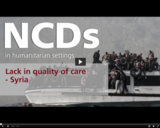
Coming....
- Subject:
- Health and Medical Science
- Material Type:
- Lecture
- Provider:
- University of Copenhagen
- Provider Set:
- NCDs in Humanitarian Settings
- Author:
- Medical Doctor Alessandro Demaio
- Date Added:
- 01/07/2018

Coming....

Coming....

Coming....

Coming....

Coming....

Coming....

Coming....

Coming....

Coming....

The aim of this presentation is to increase the students’ knowledge about the OPUS project and how an intense communication effort, from the very beginning and throughout the project was a key element of the project. It offers an insight into how science and communication strategies can go hand in hand for the benefit of both science and the public.

In this presentation, PhD in Human Nutrition Charlotte Mithril presents data from her PhD project, which aimed to develop the New Nordic Diet. In continuation of this, Charlotte Mithril introduces why there is a need for a New Nordic Diet in the first place and how this interplays with the existing dietary guidelines in Denmark.

In this video lecture, the Danish chef and food consultant Mathias Holt, talks about his work in developing the principles behind the New Nordic Diet. He also touches upon why and how to bring the principles into people’s kitchens. Furthermore, Mathias Holt will introduce the development and progression of the new Nordic diet and the organization and development of the School Intervention.

The aim of this presentation is to expand the students’ knowledge about industrially produced trans fat (artificial trans fat). We will focus on how and why we produce trans fat. Furthermore, we will focus on the health consequences of eating trans fat.

This presentation discuss how important physical activity and sleep in children is if you want to prevent obesity and cardiovascular disease. We will present the main cross sectional results from the OPUS School Meal Study. The focus will be on screen time for children, the amount of moderate-to-vigorous physical activity (MVPA), and sleep time. We will also touch upon differences in boys and girls as well as week and seasonal patterns.

Diet and other lifestyle factors have become major drivers of morbidity and mortality in most parts of the world. It is therefore a focus area in nutritional science to search for improvements in local or global food culture that could affect health. The health effects of Nordic foods are currently a highly investigated subject, and therefore we will introduce the methods and finding of different health studies of the New Nordic Diet, hereby the NORDIET, SYSDIET and the SHOPUS Study.

How can we investigate if schoolchildren become healthier and more concentrated when we replace their habitual lunch packs with school meals based on the New Nordic Diet? This is the focus of this presentation. We will introduce the whole design, the rationale, and the concept of the OPUS School Meal Study.

In the presentation, we will introduce the health benefits of the New Nordic Diet based on existing research. We will also present a broader picture of the New Nordic Diet, a more holistic perspective on how the diet can be part of a more sustainable development. Finally, we will look at some of the challenges the New Nordic Diet faces in relation to implementation.

The aim of this presentation is to expand the students’ knowledge about the OPUS School Meal Study, and presents some of the most interesting results and conclusions of the study regarding the impact of introducing New Nordic Diet in a school setting. Furthermore, we will focus on the cardiometabolic health markers in children.

In this presentation, we will focus on the SHOP system and ow is has affected the participant’s health. In continuation of this, we will provide an introduction, to the computer system, developed to monitor and control the participant’s nutritional composition of the food they collected in the shop.

The aim of this presentation is to expand the students’ knowledge about the SHOPUS (Shop-in-OPUS) project, which tests the health benefits of the New Nordic Diet on adults. Furthermore, we will discuss why the use of a shop model may be a better way to test the health benefits of diets.